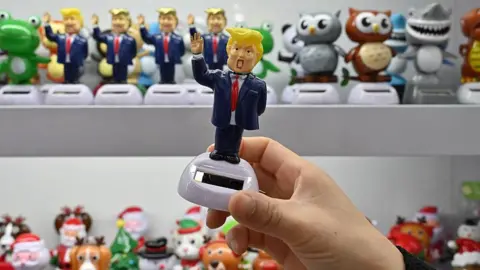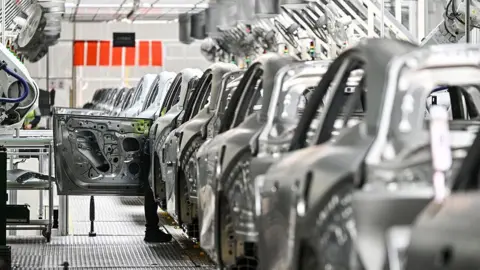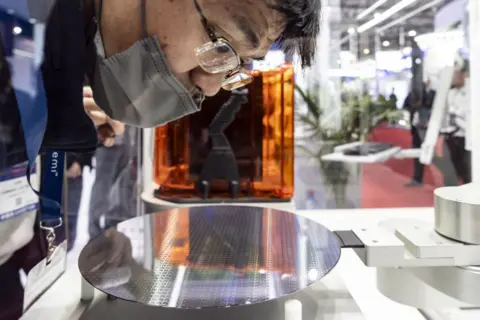 Getty Images
Getty ImagesA trade war between the world’s two biggest economies is now in full swing.
Chinese exports to the US face up to 245% tariffs, and Beijing has hit back with a 125% levy on American imports. Consumers, businesses and markets are braced for more uncertainty as fears of a global recession have heightened.
Chinese President Xi Jinping’s government has repeatedly said it is open to dialogue, but warned that, if necessary, it would “fight to the end”.
Here’s a look at what Beijing has in its arsenal to counter US President Donald Trump’s tariffs.
China can take the pain (to a point)
 Getty Images
Getty ImagesChina is the world’s second-largest economy, which means it can absorb the impacts of the tariffs better than other smaller countries.
With more than a billion people, it also has a huge domestic market that could take some of the pressure off exporters who are reeling from tariffs.
Beijing is still fumbling with the keys because Chinese people are not spending enough. But with a range of incentives, from subsidies for household appliances to “silver trains” for travelling retirees, that could change.
And Trump’s tariffs have given the Chinese Communist Party an even stronger impetus to unlock the country’s consumer potential.
The leadership may “very well be willing to endure the pain to avoid capitulating to what they believe is US aggression”, Mary Lovely, a US-China trade expert at the Peterson Institute in Washington DC, told BBC Newshour earlier this month.
China also has a higher threshold for pain as an authoritarian regime, as it is far less worried about short-term public opinion. There is no election around the corner that will judge its leaders.
Still, unrest is a concern, especially because there is already discontent over an ongoing property crisis and job losses.
The economic uncertainty over tariffs is yet another blow for young people who have only ever known a rising China.
The Party has been appealing to nationalist sentiments to justify its retaliatory tariffs, with state media calling on people to “weather storms together”.
President Xi Jinping may be worried but, so far, Beijing has struck a defiant and confident tone. One official assured the country: “The sky will not fall.”
China has been investing in the future
 Getty Images
Getty ImagesChina has always been known as the world’s factory – but it has been pouring billions into becoming a far more advanced one.
Under Xi, it has been in a race with the US for tech dominance.
It has invested heavily in homegrown tech, from renewables to chips to AI.
Examples include the chatbot DeepSeek, which was celebrated as a formidable rival to ChatGPT, and BYD, which beat Tesla last year to become the world’s largest electric vehicle (EV) maker. Apple has been losing its prized market share to local competitors such as Huawei and Vivo.
Recently Beijing announced plans to spend more than $1tn over the next decade to support innovation in AI.
US companies have tried to move their supply chains away from China, but they have struggled to find the same scale of infrastructure and skilled labour elsewhere.
Chinese manufacturers at every stage of the supply chain have given the country a decades-long advantage that will take time to replicate.
That unrivalled supply chain expertise and government support have made China a formidable foe in this trade war – in some ways, Beijing has been preparing for this since Trump’s previous term.
Lessons from Trump 1.0
 Getty Images
Getty ImagesEver since Trump tariffs hit Chinese solar panels back in 2018, Beijing sped up its plans for a future beyond a US-led world order.
It has pumped billions into a contentious trade and infrastructure programme, better known as the Belt and Road initiative, to shore up ties with the so-called Global South.
The expansion of trade with South East Asia, Latin America and Africa comes as China tries to wean itself off the US.
American farmers once supplied 40% of China’s soybean imports – that figure now hovers at 20%. After the last trade war, Beijing ramped up soy cultivation at home and bought record volumes of the crop from Brazil, which is now its largest soybean supplier.
“The tactic kills two birds with one stone. It deprives America’s farm belt of a once‑captive market and burnishes China’s food security credentials,” says Marina Yue Zhang, associate professor at the University of Technology Sydney’s Australia-China Relations Institute.
The US is no longer China’s biggest export market: that spot now belongs to South East Asia. In fact China was the largest trading partner for 60 countries in 2023 – nearly twice as many as the US. The world’s biggest exporter, it made a record surplus of $1tn at the end of 2024.
That doesn’t mean the US, the world’s biggest economy, is not a crucial trading partner for China. But it does mean it’s not going to be easy for Washington to back China into a corner.
Following reports that the White House will use bilateral trade negotiations to isolate China, Beijing has warned countries against “reaching a deal at the expense of China’s interests”.
That would be an impossible choice for much of the world
“We can’t choose, and we will never choose [between China and the US],” Malaysia’s trade minister Tengku Zafrul Aziz told the BBC last week.
China now knows when Trump will blink
 Getty Images
Getty ImagesTrump held firm as stocks plummeted following his sweeping tariffs announcement in early April, likening his staggering levies to “medicine”.
But he made a U-turn, pausing most of those tariffs for 90 days after a sharp sell-off in US government bonds. Also known as Treasuries, these have long been seen as a safe investment. But the trade war has shaken confidence in the assets.
Trump has since hinted at a de-escalation in trade tensions with China, saying that the tariffs on Chinese goods will “come down substantially, but it won’t be zero”.
So, experts point out, Beijing now knows that the bond market can rattle Trump.
China also holds $700bn in US government bonds. Japan, a staunch American ally, is the only non-US holder to own more than that.
Some argue that this gives Beijing leverage: Chinese media has regularly floated the idea of selling or withholding purchases of US bonds as a “weapon”.
But experts warn that China will not emerge unscathed from such a situation.
Rather, it will lead to huge losses for Beijing’s investments in the bond market and destabilise the Chinese yuan.
China will only be able to exert pressure with US government bonds “only up to a point”, Dr Zhang says. “China holds a bargaining chip, not a financial weapon.”
A chokehold on rare earths
 Getty Images
Getty ImagesWhat China can weaponise, however, is its near monopoly in extracting and refining rare earths, a range of elements important to advanced tech manufacturing.
China has huge deposits of these, such as dysprosium, which is used in magnets in electric vehicles and wind turbines, and Yttrium, which provides heat-resistant coating for jet engines.
Beijing has already responded to Trump’s latest tariffs by restricting exports of seven rare earths, including some that are essential for making AI chips.
China accounts for about 61% of rare earths production and 92% of their refining, according to estimates by the International Energy Agency (IEA).
While Australia, Japan and Vietnam have begun mining for rare earths, it will take years before China can be cut out of the supply chain.
In 2024, China banned the export of another critical mineral, antimony, that is crucial to various manufacturing processes. Its price more than doubled amid a wave of panic buying and a search for alternative suppliers.
The fear is that the same can happen to the rare earths market, which would severely disrupt various industries from electric vehicles to defence.
“Everything you can switch on or off likely runs on rare earths,” Thomas Kruemmer, director of Ginger International Trade and Investment, told the BBC previously.
“The impact on the US defence industry will be substantial.”








